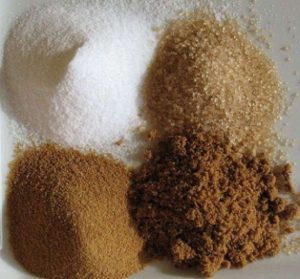White sugar has acquired a bad reputation as it provides empty calories and is associated with obesity, tooth decay, diabetes, cardiovascular diseases, and other health issues. As a result, raw unrefined sugar is used by an increasing number of people to replace its processed counterpart because of the assumption that it’s healthier and more nutritious than white sugar.
The differences between white, brown, and raw sugar
There are two plants where sugar is produced from sugarcane and sugar beet. The raw sugar that is available for consumption usually derives from sugarcane. The sugarcane juice is mixed with lime (calcium hydroxide) to clarify it and heated to kill enzymes. The result is a thin syrup which is reduced by evaporation in vacuum containers to produce a supersaturated solution that promotes sugar crystallization. The sugar crystals are then separated from the remaining fluid in large centrifuges. The result is what we know as raw sugar. Its color is brown due to the presence of molasses.
Several types of raw sugar are currently popular such as turbinado, demerara and muscovado. Turbinado and demerara sugars are produced by crystallizing raw sugarcane juice and spinning it in a centrifuge. Muscovado sugar is made by allowing the sugarcane juice to evaporate naturally. The result is a damp sugar with smaller crystals than turbinado sugar and a stronger flavor.
Raw sugar is further processed to get white sugar. Raw sugar is dissolved into syrup and clarified with sulfur or carbon dioxide to remove impurities. The clarified syrup is then bleached by filtering it through a bed of activated carbon or ion-exchange resin (in some modern sugar refineries). Finally, white refined sugar is produced by repeatedly evaporating the purified syrup in vacuum containers and centrifuging the supersaturated solution.
Brown sugar is often considered the same as raw sugar, which is incorrect. Brown sugar is in fact white sugar with molasses (that was removed during the refining process) added back in.
Nutritional Value
Brown sugar (unpacked) – per serving, one teaspoon weighing 3 g
- Calories – 11
- Carbohydrates – 2.94 g, of which sugars – 2.91 g
- Calcium – 2 mg
- Potassium – 4 mg
- Sodium – 1 mg
- Magnesium – 0.26 mg
- Iron – 0.02 mg
Raw sugar (turbinado) – per serving, one teaspoon weighing 4.6 g
- Calories – 18
- Calcium – 1 mg
- Potassium – 1 mg
- Sodium – 0 mg
- Magnesium – 0 mg
- Iron – 0.02 mg
White sugar (granulated) – per serving, one teaspoon weighing 4.2 g
- Calories – 16
- Carbohydrates – 4.2 g, of which sugars – 4.19 g
Several types of B vitamins and minerals, such as zinc, copper, manganese, and phosphorus, are also present in all types of sugar, in infinitesimal amounts.
Is sugar good or bad for you?
According to the American Heart Association, women should limit their daily sugar consumption to 100 calories (approximately 6 teaspoons), and men should not consume more than 150 calories of sugar every day (the equivalent of 9 teaspoons). Considering the recommended quantities of daily sugar intake and the nutritional values of all types of sugar, the amounts of vitamins and minerals provided by sugar bring an insignificant contribution compared to adult requirements.
The only positive aspect of raw sugar is the fact that it is less processed than white sugar and it has a unique flavor that many people seem to enjoy. In terms of calories and nutritional value, the differences between the various types of sugar are negligible.


